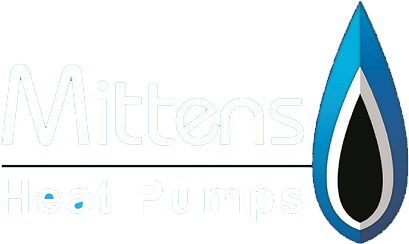Air Conditioning and Heat Pumps
Table of Contents
- 1 - Heating and Cooling your Property with Air Conditioning and Heat Pumps
- 2 - Cons of Air Source Heat Pumps
- 2.1 - Radiators may have to be Modified
- 2.2 - Air-source Heat Pumps are not Appropriate for all Facilities
- 2.3 - Higher Costs
- 2.4 - Resemble Air-conditioning Units
- 2.5 - Can be Noisy when Running
- 2.6 - Costs of Air-to-air Heat Pumps
- 2.7 - Geothermal (Ground-source or Water-source) Heat Pump
- 2.8 - How do Ground-to-air Heat Pumps Work?
- 3 - Advantages of Ground Source Heat Pumps
- 4 - Why Air Conditioning Makes for the Best Heating
- 5 - When to Choose Ducted Air Conditioning
- 6 - When to Choose Ductless Air Conditioning
Heating and Cooling your Property with Air Conditioning and Heat Pumps
The system of HVAC (heating, ventilation, and air conditioning) is designed to meet and adjust to environmental conditions in order to improve comfort. Depending on the conditions of the outside environment, the outside air is drawn into the buildings and cooled or heated before it is transferred into the conditioned space, then reused or exhausted from the system.
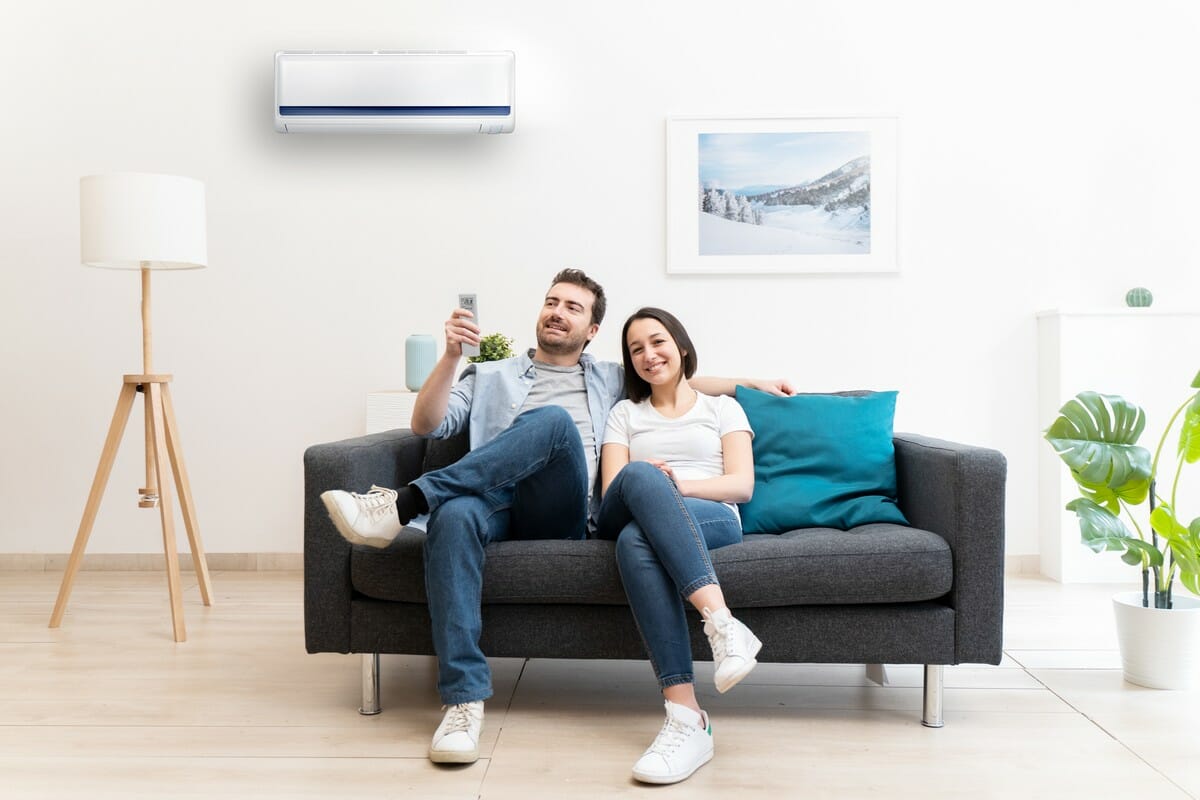
Additional processes such as dehumidification and humidification processes can also be applied. These processes can be accomplished by using appropriate HVAC equipment such as heating systems and air-conditioning systems to produce the necessary volume of air with the correct environmental conditions.
Our Guarantee
- Over Six Years Experience
- Unrivaled Experience
- An Exceptional Service
- Unbeatable Value For Money
- Industry-approved Scaffolders
- A Full Range of Heat Pumps Services
- Professional, Reliable and Diligent
- 100% Safety and Satisfaction
Air Conditioners and Heat Pumps
Homeowners today have various options for cooling and heating a home. If you need an HVAC system to help cool your house, you can use an air conditioner or heat pump to do the job. Both of these devices are fitted with liquid refrigerant to absorb heat from the interior of your home as the air moves over the coil in the air handler and transfers it to the atmosphere outside.
Literally, heat pumps and air conditioners move heat from the home environment to the outside air. Air conditioners are often thought to cool a home by generating cold air, but in actual fact, they simply cool your home by withdrawing heat energy and moving it to a location outside.
We Are Also Available to Offer Heat Pumps Related Advice
Types of Heat Pumps
Three types of heat pumps exist. They are:
- air-to-air
- ground-to-air (geothermal)
- water source
These devices absorb heat outside of your home from the air, ground, or water and concentrate it inside for use when heating your home.
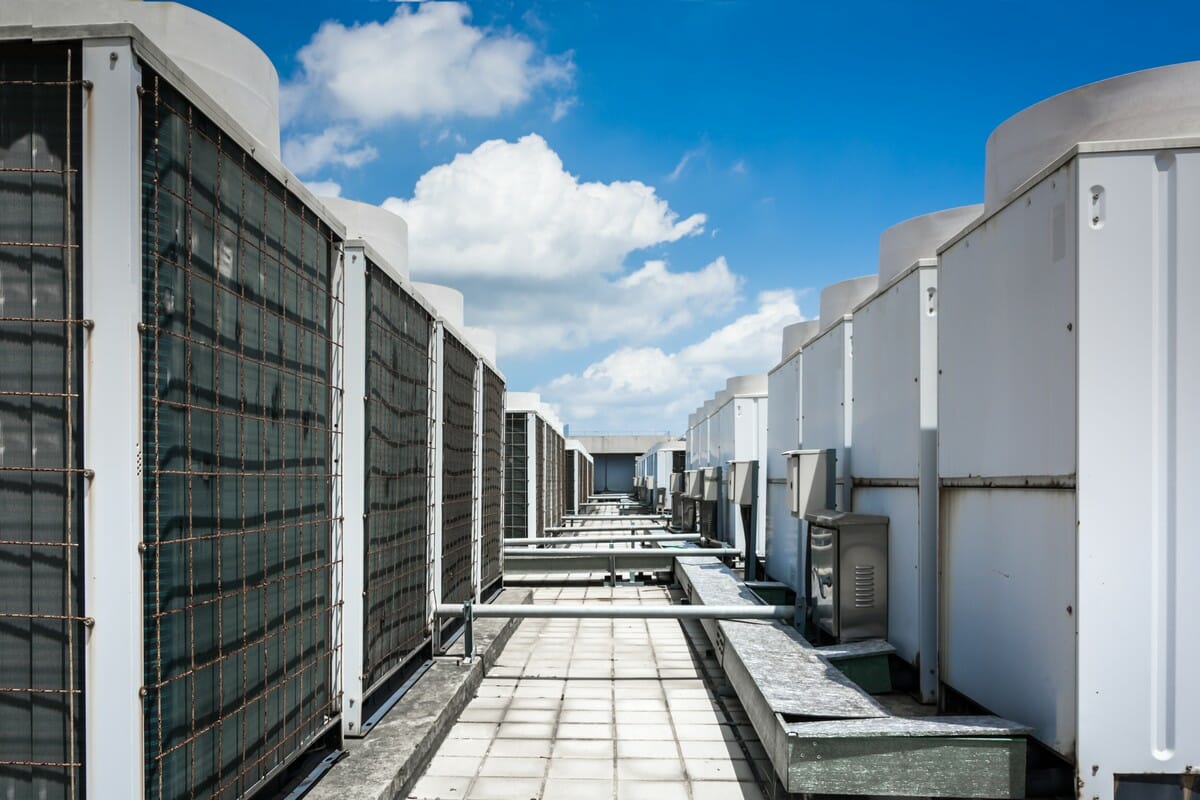
Air-Source Heat Pump
The air-source heat pump is the most common form of heat pump, which transfers heat from the outside air to your home. Compared to electric resistance heating such as baseboard heaters and furnaces, today’s heat pump can decrease your energy use for heating by about 50%. In summer months, high-efficiency heat pumps can also dehumidify better than conventional central air conditioners, leading to more cooling comfort and less energy use.
The various types of heat pumps with air source are:
- Ductless
- Ducted
- Short-run ducted
- Split
- Packaged
- Multi-zone
- Single-zone
Heat Pump Type
How do Air-to-Air Heat Pumps Work?
The refrigeration system of a heat pump consists of two coils made of copper tubing (one inside and one outside), which are surrounded by aluminium tins to help transfer heat, as well as a compressor. When the system is in heating mode, the outside coil’s liquid refrigerant removes heat from the air and changes into a vapour.
Heat is released from the indoor coils from the refrigerant as it compresses back into a liquid. In winter, a reversing valve close to the compressor will change the refrigerant’s flow direction for defrosting and cooling the outdoor coils. The performance and efficiency of the air-source heat pumps today is the result of technological advancements, such as:
- The tubing of copper, welded inside to enhance the surface area
- Thermostatic expansion valves for more accurate control of the refrigerant flow to the indoor coil
- An improved electric motor and two-speed compressor design
- Improved coil design
- Variable speed blowers that are more effective and can make up for several of the negative impacts of dirty coils, dirty filters, and restricted ducts.
Pros of Air-source Heat Pumps
Cheaper to Operate than LPG or Oil Options
Air-source heat pumps are a less expensive form of heating than LPG and oil boilers when built and designed properly. A heat pump with an air-source technology should have a COP of about three, meaning you get 3kWs of heat out of it for every 1kW of electricity that powers it.
Suitable for use with Underfloor Heating
Unlike radiators, underfloor heating works best at lower temperatures. An air-source heat pump generates heated water at a temperature of approximately 45oC. This is appropriate for underfloor heating temperatures.
Provides Less of a CO2 Footprint
Air-source heat pumps produce fewer carbon footprints than other heating systems operating on oil, LPG or gas because high-efficiency heat pumps operate using electricity.
Maintenance is Minimal
Since air-source heat pump technology has been available for decades, it is therefore highly efficient and dependable. Using the same technology as fridges and freezers, air-source heat pumps need limited maintenance.
Can be used During Summer Months to Provide Cooling
Certain air-source heat pumps can be mounted to cool your property in a reverse cycle instead of heating it, so one unit is able to provide your home with both heating and cooling.
We Are Also Available to Offer Heat Pumps Related Advice
Cons of Air Source Heat Pumps
Radiators may have to be Modified
Since air-to-air heat pumps only generate water temperatures of about 45oC only, the property’s heat emitters may have to be replaced. If panel radiators are used, they may need to be replaced with larger ones or by convection heaters such as fan radiators.
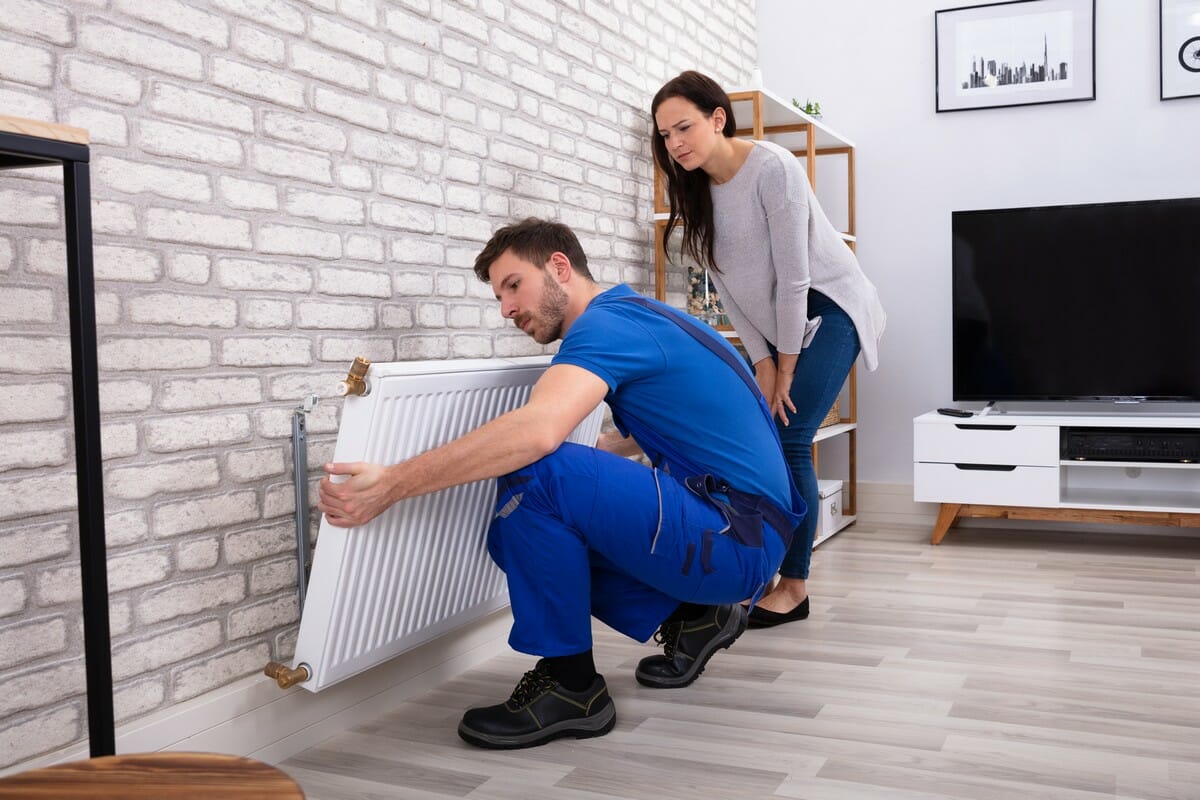
Air-source Heat Pumps are not Appropriate for all Facilities
Only draught-free and well-insulated buildings are appropriate for air-source heat pumps. Also, while conventional heating systems boost water temperatures to 75o to 80oC, air-to-air heat pumps only generate water temperatures of around 45oC. This may not be appropriate in all facilities.
Higher Costs
Although an air-source heat pump’s operating cost is lower than LPG or oil, the equipment’s capital demand is greater and the installation quite complicated. It is cheaper to replace an existing boiler with a more efficient and newer boiler in the short term. However, you’ll have higher running costs in the long run if only using a boiler.
Resemble Air-conditioning Units
We are not used to having air-to-air heat pumps outside of our properties in the UK. Air-to-air heat pumps share many similarities with air-conditioning units and you should know where they must be situated because they are not usually regarded to be aesthetically pleasing, but then again they are not LPG or oil burners!
We Are Also Available to Offer Heat Pumps Related Advice
Can be Noisy when Running
Air-source heat pumps make a noise when running as they have a compressor and a fan just as your refrigerator does. They’re going to make a humming sound but most of them are not over 48 decibels and can be very quiet.
Costs of Air-to-air Heat Pumps
An air-to-air heat pump installation cost ranges from £7,000 to £11,000. The price of the installation can vary based on different regions across the UK. Installation costs also depend on the size of your home and the device you select. Your system’s efficiency will determine whether or not you will get your money back after installing an air-source heat pump system. The way you use the heat produced will also have an impact on the extent to which you recoup your outlay expense. Another critical factor determining the payback period is what form of fuel source you are substituting.
Geothermal (Ground-source or Water-source) Heat Pump
Geothermal heat pumps (ground-source or water-source) attain higher efficiency improvements by transferring heat between the ground and your house or a nearby source of water. Although geothermal heat pumps are more expensive to install, they have lower operating costs as they utilise relatively constant water or ground temperatures.
Ground source heat pumps have a number of significant advantages. They can mitigate power consumption by 60%, fit in a wide range of homes, are robust and reliable, and control humidity. You can determine if a geothermal heat pump is a good option for your home based on your landscape, the subsoil, and the size of your property.
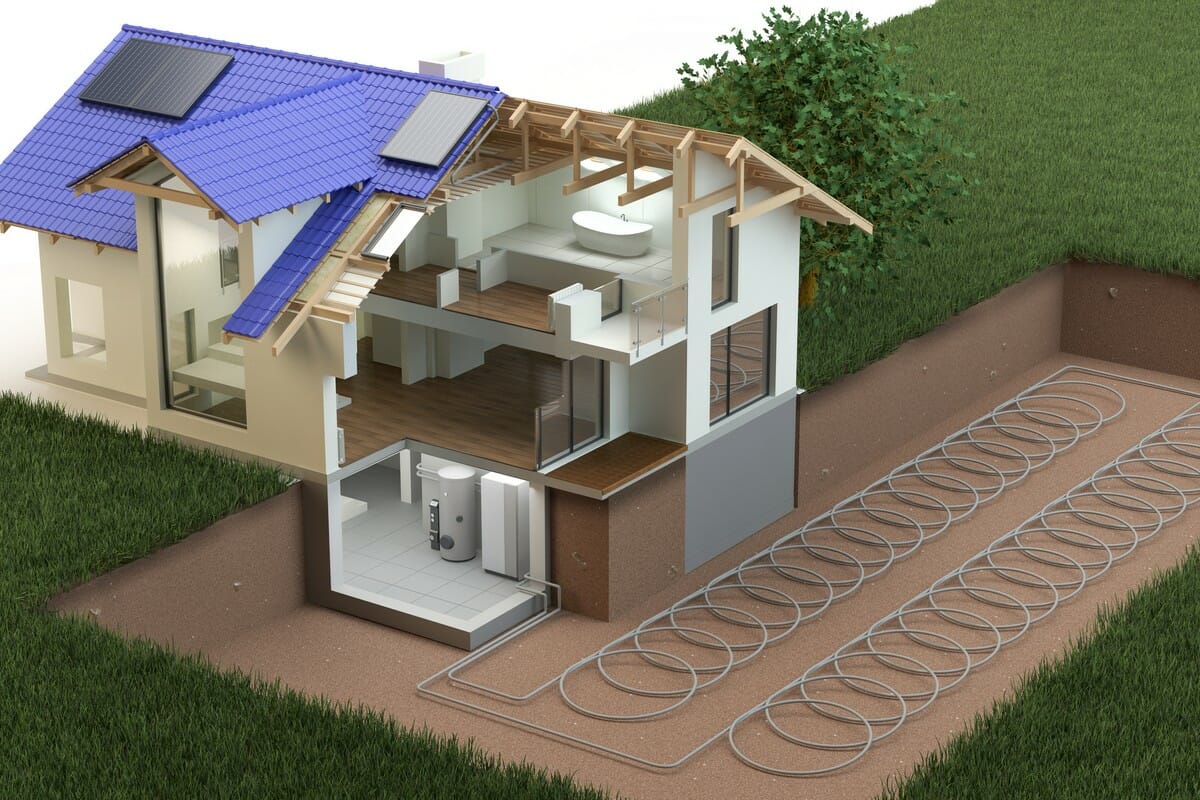
How do Ground-to-air Heat Pumps Work?
A ground source heat pump system is a ground-loop system that incorporates a building’s ductwork, a heat exchanger, and a water solution. The water solution absorbs heat from the ground during the winter as it circulates through pipes in the ground.
The warmed water is transported into the home where the thermal energy is concentrated by a water-to-air heat pump which, in turn, converts it to air in a traditional ductwork system which is circulated for heating the house.
This process becomes reversed in the summertime, and excess heat is either diverted to heat hot domestic water or drained from the home into the ground. Besides space heating, geothermal heat pumps can also be fitted with a component known as a desuperheater, which allows for the recycling of the waste heat from the compressor, using it to heat water.
In addition to augmenting a conventional water heating system or solar-thermal water heater, these devices may provide hot water for home use. This is particularly effective during summer as the excess heat drained from the home is diverted to the hot water tank to provide free hot water instead of returning it to the ground.
The heat from the ground can also be used for heating the home as well as water during the winter, even reducing the heating of winter water by fifty per cent.
Advantages of Ground Source Heat Pumps
The following list includes what we consider to be some of ground source heating pumps’ most outstanding benefits:
- Their maintenance costs are very low in comparison to heating systems that run on direct electricity. That is because ground source heating pumps’ primary element that requires electric energy usage is the compressor.
- A ground source heat pump does not involve the use of any fuel and does not produce on-site carbon emissions. Additionally, if they are powered by a renewable source of electricity, they do not generate carbon emissions at all.
- Unlike air conditioners which require the use of a furnace for heating, a ground source heat pump can provide both heating and cooling. This is achieved through an inverter valve that moves the fluid’s direction of circulation.
- The energy source for ground source heat pumps, known as geothermal energy, is inexhaustible and constantly available and has massive potential. If the ground source heat pump is well planned, then the value of your property will also increase.
Get in Touch With us for Your Heat Pump Hire Quotes
Disadvantages of Ground Source Heat Pumps
The list below shows the most likely ground source heat pump-related disadvantages:
- Geothermal energy is specific for a particular location. That implies that there is no equal distribution. Besides that, its transport and exploitation systems are unable to transfer that energy over a long distance without substantial loss of energy.
- The ground source heat pumps’ installation costs are significantly higher than the installation costs of an air conditioner and a traditional furnace. This requires a fairly costly upfront investment.
- A ground source heat pump with closed-loop technology uses chemical agents over the entire system. On the other hand, an open-loop requires enormous amounts of water.
How Much Does a Ground Source Heat Pump Cost?
How much it costs to install a ground source heat pump will vary due to a variety of factors. In general, a ground source heat pump typically costs between £20,000 and £45,000. This depends on what type of ground source heat pump you want to install. A vertical ground source heat pump will cost more, and you should be prepared to pay £30,000 to £45,000 as the installation process requires experts to dig deep into the ground, usually about fifty to hundred meters deep.
On the other hand, a horizontal ground source heat pump only needs to be drilled 1 to 2 metres into the ground, leading to a reduced cost of installation. Usually, a horizontal system costs between £20,000 and £35,000. You must bear in mind these several cost factors when considering ground source heat pumps for your home:
- Financial support schemes such as the RHI
- Installation fee
- Type of system
- Size of the system
A ground source heat pump pays for itself in lower cooling and heating costs as well as RHI payments even though it is a huge investment.
Why Air Conditioning Makes for the Best Heating
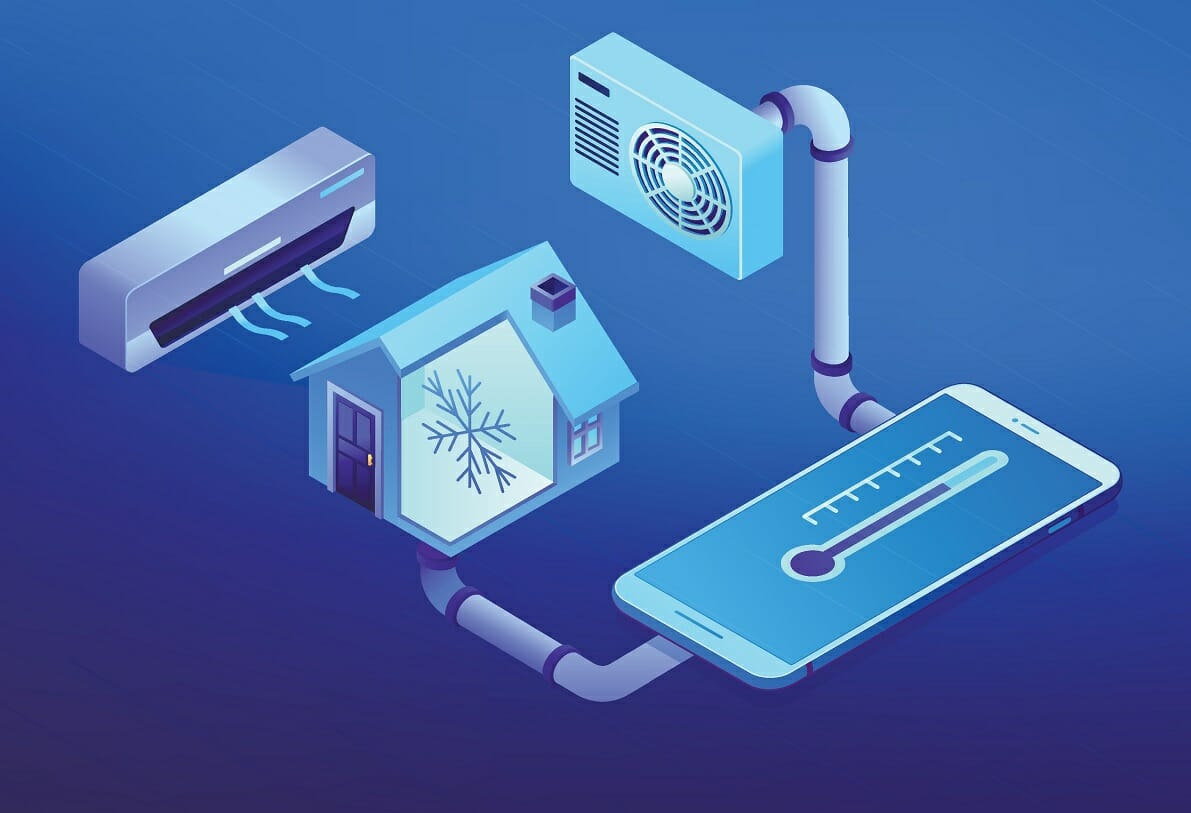
A split system heat pump can be installed both ways too. The airflow changes to heat up and to cool down your home when paired with an air handler. The dual-fuel alternative incorporates a gas-furnace with the heat pump.
What Types of Air Conditioning are There?
Choosing a new air-conditioning system can be both confusing and stressful. The wide range of possibilities seems rather overwhelming with there being so many types of air conditioners on the market. Below are the types of air-conditioning systems you can choose from, depending on your situation.
Ductless Mini-split Air Conditioner
Ductless, mini-split air-conditioning systems are particularly prevalent in retrofitted parts of the home. These systems have an indoor handling unit and an outdoor condenser/compressor, as do central air-conditioning systems. If you need to have single rooms cool in your house, this device is appropriate for this type of requirement.
Ductless, mini-split systems often have several handling units for indoor use, all connected to the outside unit. All the zones have their individual thermostats which allow you to adjust the temperatures accordingly for each room. This is particularly advantageous if you want only a specific room in your home to cool individually.
Central Air Conditioning
This is the most common type of cooling system of all the different types of air conditioners since it is the most preferable type for bigger houses, owing to its capacity to cool efficiently. The cool air circulates from return and supply ducts through central air conditioners.
Registers and supply ducts in the floors or walls convey cooled air into the house. The air then flows back into the registers and supply ducts once it gets warm, where it is then returned to the air conditioner.
Window Air Conditioner
This is a compact unit which cools one room only. This system is also known as a unitary machine and is mounted in a room window. A window air-conditioning unit cools a room by transmitting warm air from the rear and blasting cool air into it. For those who reside in small places, this type of unit is the best. It wouldn’t be optimal for a bigger apartment as it doesn’t efficiently cool that type or size of the environment.
Portable Air Conditioner
This form of air-conditioning unit cools the air it takes in from the room and recirculates it. Using an exhaust hose that is mounted in a window, the unit then expels any warm air. Portable air conditioners, such as window air-conditioning units, are created for single room use. They’re affordable, flexible, and simple to install.
When to Choose Ducted Air Conditioning
When Enhanced Airflow Is Needed
Better air ventilation can be also accomplished by installing a ducted air-conditioning system. Since ductless air-conditioning units cool the air in each room individually, the air movement in the living space will be decreased which can sometimes lead to air pressure issues and hot air.
When Humidity is an Issue
When you install a ducted air-conditioning system, the humidity control is smooth. The air handlers found in ductless air-conditioning units, however, do not have the mechanisms that are necessary for the elimination of heavy humidity and its draining from the air.
When There are Existing Ducts in the Space
If you already have ductwork installed and it is in perfect shape, a lot of professionals recommend installing a ducted device. The installation process consists simply of connecting the existing ventilation to a new unit. It’s quicker and less onerous.
When Appearance Matters
A major preoccupation is often presented. This may also be a justification to choose a ducted air-conditioning system. From an aesthetic point of view, air handler boxes placed on the ceiling or wall of each room are not always suitable for a ductless air-conditioner unit. Anything with a ducted system is hidden both in crawl spaces and behind walls.
Reduced Maintenance Costs
The ducted air-conditioning systems are less expensive and easier to use because there are fewer components. They just need periodic cleaning. There is only the main indoor air handler and the external air handler that require attention. Ductless air-conditioning systems, however, require continuous operation and attention, as they have air handlers in each room.

We Are Also Available to Offer Heat Pumps Related Advice
When to Choose Ductless Air Conditioning
For Multiple Cooling Zones
Because the air handlers are separated in each room when using ductless air-conditioning systems, they can be independently controlled for different temperature requirements. That means you can increase the temperature in the bedroom where the baby is sleeping while lowering the temperature in the living room where you may be entertaining a group of people.
There is no Room in the Ceilings or Walls for Ducts
If there is no room for ducts, or you just want to keep your high ceilings, then the answer is air conditioning without ducting.
You are Adding a Room
In this case, connecting to the existing system and attaching ducts to the new space could be difficult or costly. Your machine may not be capable of cooling the extra space. Nevertheless, a small ductless air-conditioning system can be installed in the new space. A ductless unit is sometimes used in new construction to provide zoned ventilation for an area that isn’t frequently occupied.
The Mittens Heat Pumps UK is Available to Assist you
Whether you’re buying an HVAC system for the first time or looking to replace an existing one for your home, there are several important differences to consider when choosing between an air conditioner and a heat pump. In addition to selecting the most appropriate device for your situation, the size of the unit and its cooling or heating power should be calculated. A full assessment by a qualified, HVAC-skilled technician concerning your cooling and heating needs is the best way to identify the ideal option for you.
The Mittens Heat Pumps UK can help you assess the situation and help you decide between a heat pump system and an air conditioner. Although it may be difficult to find professional installers for ducted and ductless mini-split systems, Mittens Heat Pumps UK has years of expertise in cooling and heating, including years of experience in installing ductless and ducted systems in homes across the UK. Call us today for a free quote on 01273257407!
Get in Touch With us for Your Heat Pump Hire Quotes
